Part 1 of 4 of the series: When Life and Death is “A Matter of Policy”
As I mentioned recently in the quasi-mission statement of the blog, I create bloggings to ask the right questions, to illuminate the unseen issues facing us ignored vulnerable groups, or that’s the goal. Within that is the idea that the questions mainstream media asks are THE WRONG QUESTIONS, and that the issues facing vulnerable groups that really need advocates (e.g. families with medically complex children, people on mechanical ventilation, the population who faces poverty solely/primarily because of their disabling medical conditions) are largely unseen… therefore I keep blogging to fill that gap, to voice the unheard concerns.
One huge umbrella of concerns affecting me and others in the aforementioned unseen groups is the top-down rules and regulations imposed on us. For us, there are the laws, but in terms of the ad-hoc jumble of non-systems that control the services and supports essential to our survival—much less quality of life—there are all the rules and regulations implementing the laws, and rules more local to us coming from home health agencies, state regulators and Medicaid offices, hospital administrators, the list goes on and could cover a number of pages unheard-of except for in encyclopedias, and these rules and regulations govern our lives just as much as the actual laws (if not moreso).
The bureaucratic octopi have tentacles everywhere, and they’re especially consequential in medical bureaucracy where people are at their most vulnerable and any tweak in the rules can change the care, and suddenly life and death is “a matter of policy,” not just about the right care at the right time. That can kill.
Medical Staff Too Often Directed to Do Things for No Discernable Medical Purpose
The actual lived experience with medibureaucracy matters most here, as the data to prove or disprove the impact of diverse millions of rules on untold millions of individual staff and patients doesn’t exist. One especially vexing hospital policy that I run into frequently is the “no foreign ventilators” policy, and it is so frustrating because it’s purely a problem of legalese, not a matter of the appropriate medical treatment…it’s simply “a matter of policy,” outside treatments and prescriptions, and therefore outside of the patient’s right to refuse treatment. I don’t single out one hospital, all hospitals do this. If somehow your hospital is the same company as the DME (Durable Medical Equipment) company providing your home ventilator, there’s probably no issue of hospital non-ownership or fear of an unknown machine, and it’d be fine, but otherwise, the bureaucrats are likely to deem the liability risk of “OMG foreign equipment” worse than the risks of changing you to a hospital vent, even if the opposite is true.

I would like to see a study of the effect of taking people off their vent in favor of a hospital vent for No Discernable Medical Purpose (NDMP). This could be done as a basic hospital exit survey or a more detailed “qualitative analysis” or something to discern the wider reality: for most of the people affected, is switching vents solely because they’ve switched care/legal jurisdictions (and for NDMP) a traumatic and risky thing, or is switching to a hospital vent more like switching to a new toothbrush for most, no biggie? I definitely fall into the former category, my lungs maintaining a delicate balance against “compressive atelectasis“—my spine smushing into the right middle lung—equilibrium created by high volume ventilation that can quickly deteriorate, lungs partly collapsing and all hell breaking loose when hastily forced on a different form of mechanical ventilation with different (inappropriately low) volume nearly 18 months ago subsequent to an exploratory thingy in the OR. But I don’t know that most permanently vented patients react similarly….
While this is also an issue of patients like me who are so RARE they don’t match any of the hospital protocols or norms of practice, square peg vs. round hole, my focus in this series is the medical bureaucracy’s whole canon of weird rules, potentially affecting anyone, especially insofar as the rules and policies create staff actions that serve No Discernable Medical Purpose (NDMP).
Nick
intro post of my Series When Life and Death is “A Matter of Policy”
In Part 2, Paramedics, the VA, and doing things for NDMP
Part 3: the Milgram experiment and hospital ethics
Part 4: activism and rays of hope from medical bloggers
